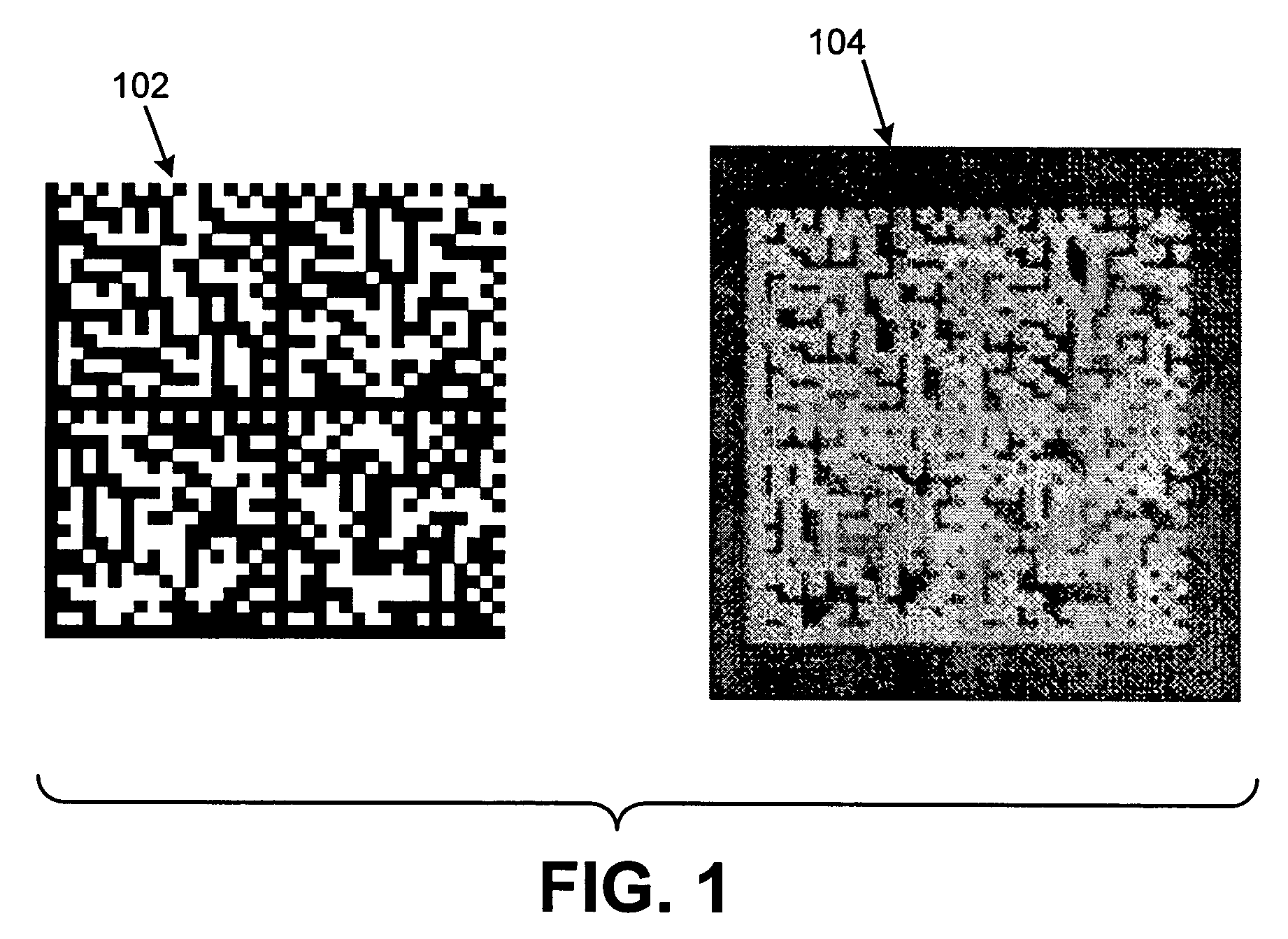Photosensitive optically variable ink compositions useful for ink jet printing
a technology of optical variable ink and composition, which is applied in the direction of luminescent compositions, inks, instruments, etc., can solve the problems of limiting the ability of the detector to verify the authenticity of the security marking, the inks present a significant challenge in providing solution stability and water fastness in the same, and the tendency to produce poor water fastness, etc., to achieve satisfactory water solubility, low water fastness, and the effect of red fluorescen
- Summary
- Abstract
- Description
- Claims
- Application Information
AI Technical Summary
Benefits of technology
Problems solved by technology
Method used
Image
Examples
example 1
[0046]This example illustrates an improvement in water fastness for an ink formula of the invention containing a colloidal blue pigment as a component of the second colorant as compared to a similar formulation containing a blue dye. Strong improvements are shown in terms of higher Reflectance ratio and Modulation (RGB).
[0047]
Ink with Ink withBlue PigmentBlue DyeComponentsWt (%)Wt (%)Distilled Water67.6672.2Triethanolamine (TEA)0.290.314-methymopholine-N-Oxide (MMNO)1.932.065,5-Dimethyl hydantoin formaldehyde5.806.19Triethylene Glycol Mono Butyl Ether2.903.09(BTG)Dodecylbenzene sulphonic acid (DBSA)0.480.52Glycerol6.076.481,2,4-butanetriol3.854.10Urea1.902.03Acid Yellow 7 (Pylam, 500%)0.350.37Acid Red 52 (Pylam, 400%)0.430.45Pyranine 120 (Bayer)1.111.19Degussa R-4071 Blue Pigment7.23—DispersionInk with Millijet Blue Dye 28—0.99Total100.00100.0Properties of Drawdown and InksInk withInk withBlue PigmentBlue DyePMU (drawdown)8260OD (drawdown)0.670.67pH7.547.43Viscosity (cp)2.112.19Comp...
example 2
[0048]Another ink according to the invention was prepared from the following materials:
[0049]
ComponentsWt (%)Distilled Water70.0Triethanolamine (TEA)0.304-methylmorpholine-N-oxide (MMNO)1.86HVWT 10 5,5-Dimethyl hydantoin formaldehyde6.00Triethylene Glycol Mono Butyl Ether (BTG)3.81Glycerol4.771,2,4-butanetriol4.11Acid Yellow 7 (Pylam, 500%)0.36Acid Red 52 (Pylam, 400%)0.44Pyranine 120 (Bayer)1.15Degussa R-4071 Blue Pigment Dispersion7.20Total100.0
[0050]An ink prepared from the above was tested both as a drawdown and as printed on a GEM ink jet printer. The results are shown in the table directly following:
[0051]
Properties ofI Drawdown / Print (GEM)PMU (drawdown)74OD (drawdown)0.67PMU (Eagle area)9PMU (Indicia)21OD (Solid Area)0.65
[0052]The ink was then tested for its physical properties important to ink jet printing, with the following results:
[0053]
Properties of InkPH7.54Viscosity (cp)2.1Surface Tension41.5(Dyne / cm)
example 3
[0054]Another ink according to the invention was prepared from the following materials:
[0055]
ComponentsWt (%)H2O54.14Fluorescent Dye, Acid Yellow 7 (International Color Index0.40or C.I. 56295)Fluorescent Dye, Acid Red 52 (magenta dye)0.55Anionic Surfactant, dodecylbenzene sulfonic acid (DBSA)1.00Pyranine120 dye1.404-methylmorpholine-N-oxide (MMNO)2.00Triethylene Glycol Mono Butyl Ether (BTG)6.00Polyvinylpyrrolidone (PVP)6.00Dark Pigment, (10% solids dispersed in water) Cabot28.12Blue Pigment Dispersion, Cyan COJ 250 (PB 15:4)Surfactant, TEA (triethylamine)0.40Total100.00
[0056]The ink so prepared was tested by printing with the following results: 15PMU (Datamatrix A, B Envelope printed with HP1600C @ 300×600 DPI).
PUM
| Property | Measurement | Unit |
|---|---|---|
| particles size | aaaaa | aaaaa |
| reflectance | aaaaa | aaaaa |
| surface tension | aaaaa | aaaaa |
Abstract
Description
Claims
Application Information
 Login to View More
Login to View More - R&D
- Intellectual Property
- Life Sciences
- Materials
- Tech Scout
- Unparalleled Data Quality
- Higher Quality Content
- 60% Fewer Hallucinations
Browse by: Latest US Patents, China's latest patents, Technical Efficacy Thesaurus, Application Domain, Technology Topic, Popular Technical Reports.
© 2025 PatSnap. All rights reserved.Legal|Privacy policy|Modern Slavery Act Transparency Statement|Sitemap|About US| Contact US: help@patsnap.com


